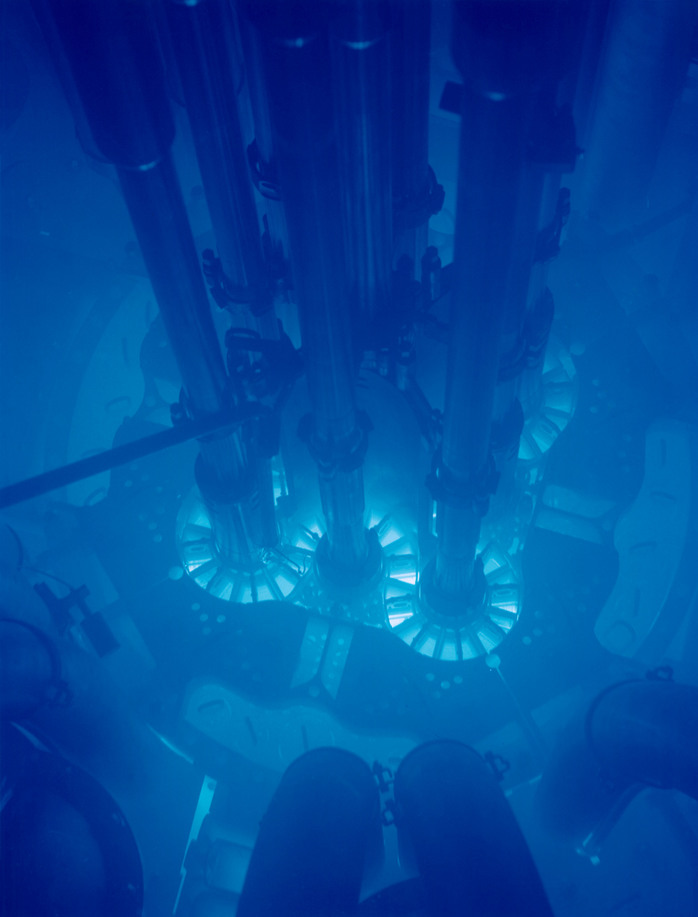
Image of the Advanced Test Reactor at the Idaho National Laboratory courtesy of Wikipedia and Argonne National Laboratory
 Copyright © Michael Richmond.
This work is licensed under a Creative Commons License.
Copyright © Michael Richmond.
This work is licensed under a Creative Commons License.
Detecting neutrinos with Cerenkov radiation
You've seen neutrino telescopes which rely upon the transmutation of one element into another to record the presence of a neutrino. But that's not the only way physicists can deduce that a neutrino has visited us. If a medium-to-high-energy neutrino smashes into a sub-atomic particle in the right way, it may send the products of the collision flying outward at very high speeds. If those particles have electric charge, and if they travel fast enough -- faster than the speed of light within some medium -- then they may emit Cerenkov radiation, which is easy to see and a dead giveaway.
What's Cerenkov radiation? One familiar example is that eerie blue glow that you see around nuclear reactors:

Image of the Advanced Test Reactor at the Idaho National Laboratory
courtesy of
Wikipedia and Argonne National Laboratory
That same blue glow was noted decades earlier by Marie and Pierre Curie, in the laboratory where they isolated radium:
After the crowded streets of this queer district, with its factory buildings, wastelands and poor tenements, they arrived in the Rue Lhomondand crossed the little courtyard. Pierre put the key in the lock. The door squeaked, as it had squeaked thousands of times, and admitted them to their realm, to their dream."Don't light the lamps!" Marie said in the darkness. Then she added with a little laugh:
"Do you remember the day when you said to me: 'I should like radium to have a beautiful colour'?"
The reality was more entrancing than the simple wish of long ago. Radium had something better than "a beautiful colour"; it was spontaneously luminous. And in the sombre shed, where, in the absence of cupboards, the precious particles in their tiny glass receivers were placed on tables or on shelves nailed to the wall, their phosphorescent bluish outlines gleamed, suspended in the night.
"Look . . . Look!" the young woman murmured.
She went forward cautiously, looked for and found a straw- bottomed chair. She sat down in the darkness and silence. Their two faces turned toward the pale glimmering, the mysterious sources of radiation, toward radium their radium. Her body leaning forward, her head eager, Marie took up again the attitude which had been hers an hour earlier at the bedside of her sleeping child.
Her companion's hand lightly touched her hair.
She was to remember for ever this evening of glow-worms, this magic.
Excerpt from "Madame Curie: A biography" by Eve Curie (her daughter), William Heinemann Ltd., (London, Toronto), 1938
How does this work? Well, you all know that no object with mass can travel at the speed of light IN A VACUUM, right? Right. But if you consider situations other than a vacuum -- for example, a big tank of water -- it turns out that objects CAN move faster than light inside that medium. The speed of light inside a medium is slower than c by a factor called n = index of refraction for the material. For water, n = 1.33, so
c
speed of light in water = ------- = 225,000,000 m/s
1.33
A sufficiently violent process can shoot a particle through water faster than this speed. If that particle is electrically charged (like an electron or a proton, but not a neutrino), the particle will emit light as it moves through the water.
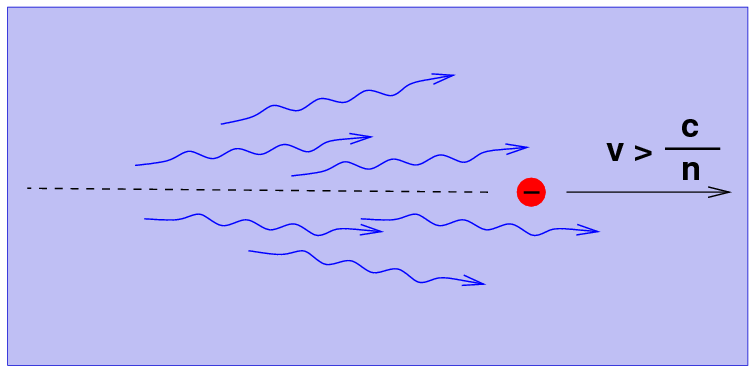
The Cerenkov light has two characteristics:
There are several ways that a neutrino can give rise to a super-luminal charged particle and Cerenkov radiation. Here are cross sections for a few of the most common (the values of which I copied from Physical Implications of the Kamioka observation of neutrinos from Supernova 1987A , by Arafune and Fukugita, Phys. Rev. Lett. 59, 367 (1987)).

The first two reactions are simple scatterings off electrons; the cross sections are roughly the size in size, and each varies linearly with the energy of the neutrino (more energy means a larger cross section). In both cases, the electron will fly forward in the same direction that the neutrino had before the collision.
The third, a reaction which converts a proton to a neutron, has a much larger cross section ... but note that it requires an electron anti-neutrino. In addition, note that the cross section depends on the SQUARE of the energy, so it will decrease more rapidly if we consider neutrinos of energy less than 10 MeV. Finally, the energy and momentum of the incoming anti-neutrino in this case is split between the positron and neutron -- which means that the positron does NOT (necessarily) move in the same direction as the anti-neutrino. In other words, in this reaction, the anti-neutrino's direction is NOT preserved.
Cerenkov-based telescopes offer the possibility of being able to detect neutrinos AND determine the direction of their sources (at least in some cases). This makes them, in my mind, "real" telescopes.
Now, Cerenkov radiation might be great for making neutrinos "visible", but it can have drawbacks, too. Suppose that one puts an ordinary, optical telescope in space, hoping to take pictures of stars and galaxies as HST and JWST do. If one's optics have any refractive elements, which act to focus the optical photons of interest, those pieces of glass will also inadvertantly intercept high-energy charged particles: cosmic rays. Some of those charged particles will exceed the speed of light in glass as they zoom through the lenses, and so will create a burst of optical photons -- interfering with our view of the distant stars and galaxies. Whoops! This "Cerenkov background" can become the dominant source of noise in the near-UV and blue portion of the optical.
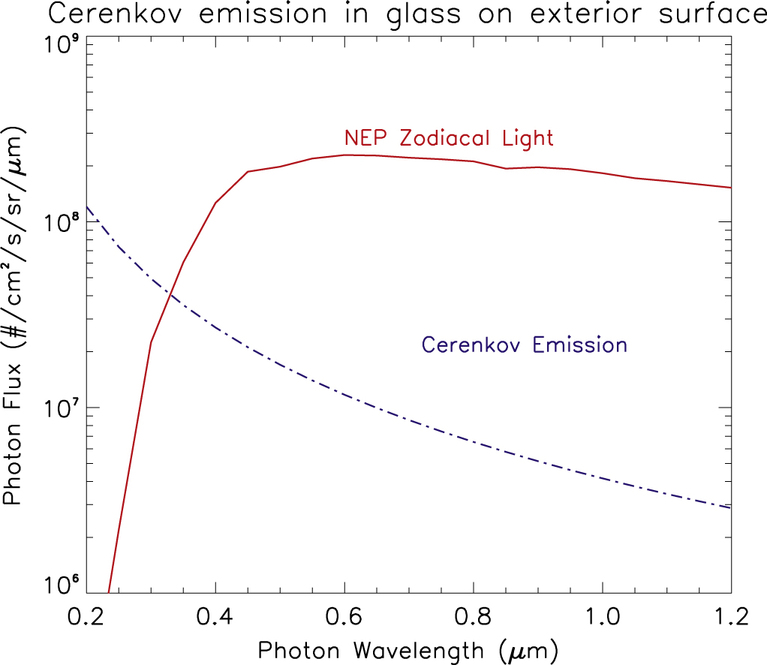
Figure 8 taken from
Kruk, J. W., et al., PASP 128, 35005 (2016) .
The caption reads
"Fig 8. The intensity of Cerenkov radiation in an optical
element exposed to the unshielded electron environment
in Geo-synchronous orbit is shown. Zodiacal light emission at
the North Ecliptic Pole is shown for comparison,
as it is the dominant astronomical background for many applications.
Cerenkov emission dominates only at UV wavelengths. This
comparison is meaningful for the case of refractive instruments
where all optical elements but the first are well-shielded.
If downstream optics are exposed to even a modest fraction
of the external electron flux, especially if downstream from
filters, then Cerenkov radiation may be a significant
source of background."
Okay, so suppose we've decided to create a Cerenkov-light-type neutrino telescope. All we need is a proper material around which to base our telescope. It should provide
Q: Can you identify a good material? Ideally, it
would be cheap and non-toxic.
Yes, water is a really good choice. But it's not the only one. As we'll see next week, air may be an even better one, in some situations.
The Super-Kamiokande experiment near Hide, Japan, is one the world's leading neutrino detectors. It has passed through several phases: Kamiokande, Kamiokande-II, and now Super-K, growing bigger and better with time. The detector sits far below the ground in an old mine:
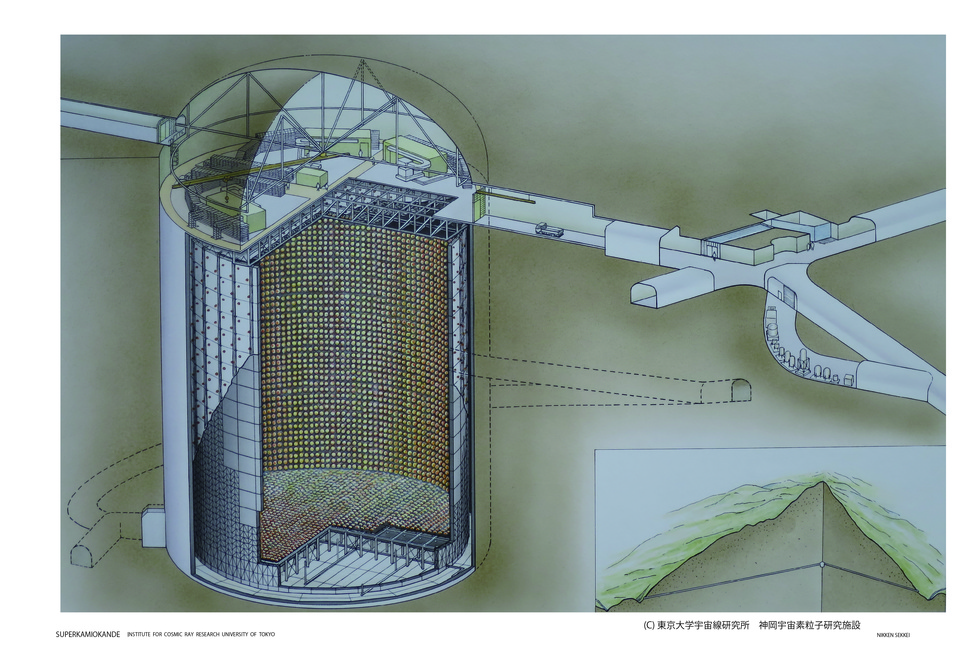
Image of Super K courtesy of
Kamioka Observatory, ICRR (Institute for Cosmic Ray Research), The University of Tokyo.
A giant tank is lined with thousands of photomultiplier tubes, which can detect individual photons of blue light with great time precision.
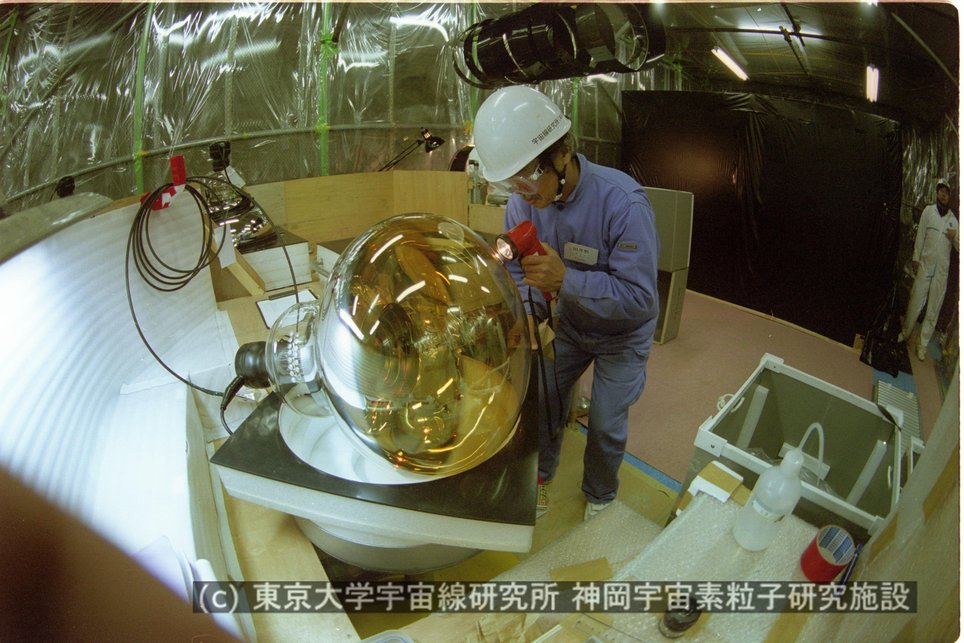
Image of PMT courtesy of
Kamioka Observatory, ICRR (Institute for Cosmic Ray Research), The University of Tokyo.
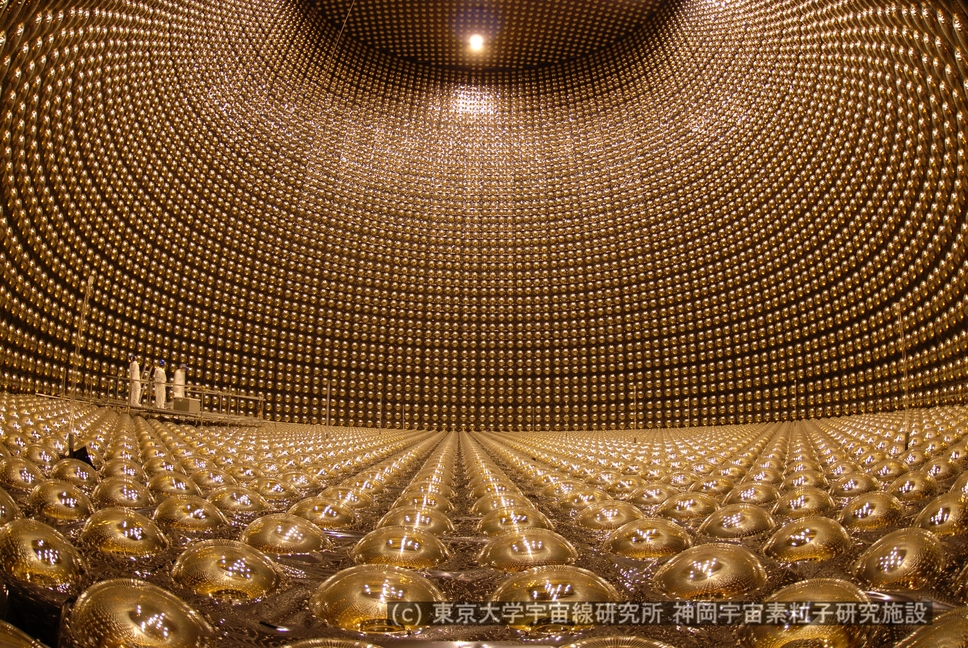
Image of Super K courtesy of
Kamioka Observatory, ICRR (Institute for Cosmic Ray Research), The University of Tokyo.
The tank is filled with water to create a big pile of protons and electrons, with which neutrinos may collide and lead to Cerenkov radiation.
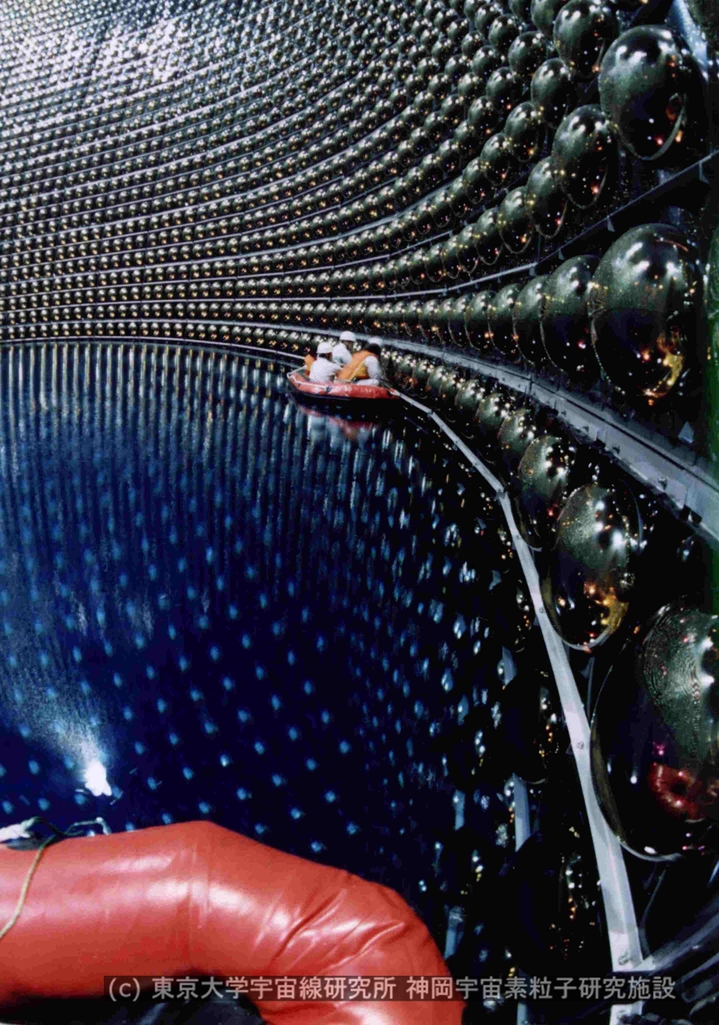
Image of Super K courtesy of
Kamioka Observatory, ICRR (Institute for Cosmic Ray Research), The University of Tokyo.
Some numbers: the tank is 39.3 meters high and 41.3 meters in diameter, and contains roughly 50 thousand tons of very pure water.
Q: What is the total number of electrons in the
Super-K water?
Q: What is the total cross-section area for
neutrino-electron scattering in Super-K?
Q: The flux of all the solar neutrinos created
by the pp-III pathway (which can have energies
up to 14 MeV) is about 1010 per sq. m. per second.
What is the rate at which neutrino-electron scattering
should occur inside Super-K?
The walls are lined with over 11,000 photomultiplier tubes. A second set of (fewer) PMTs line the outer sides of the tank, facing out towards the walls of the mine. These outer PMTs will be triggered by passing high-energy muons, but not by neutrinos, allowing the scientists to discard some muon-induced events from their data.
Below is a record of a neutrino-electron scattering event. This particular neutrino must have been coming from above, as the ring of detected Cerenkov photons appears on the bottom of the cylindrical tank.
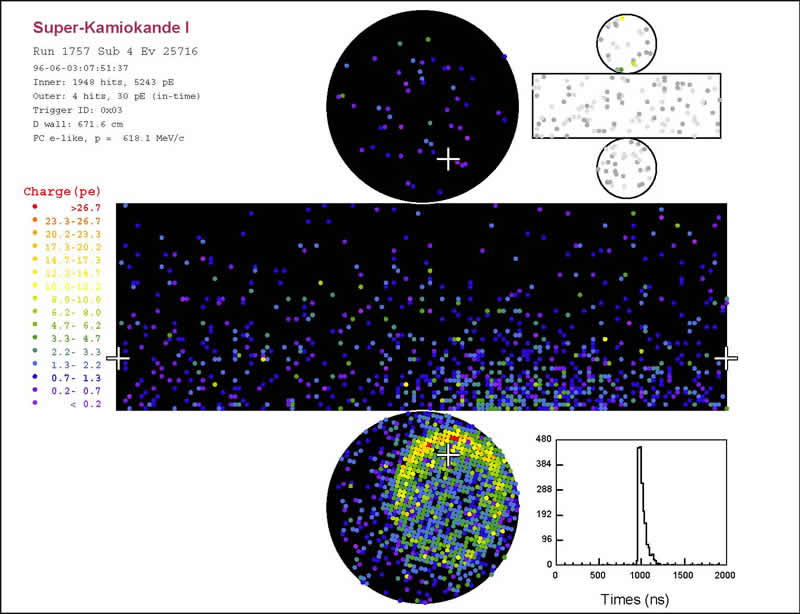
Image of neutrino event courtesy of
Kamioka Observatory, ICRR (Institute for Cosmic Ray Research), The University of Tokyo.
From the pattern of photons, scientists can determine the direction of the incoming neutrino -- to some degree. The angular resolution gets better at high energies, but it's never great:
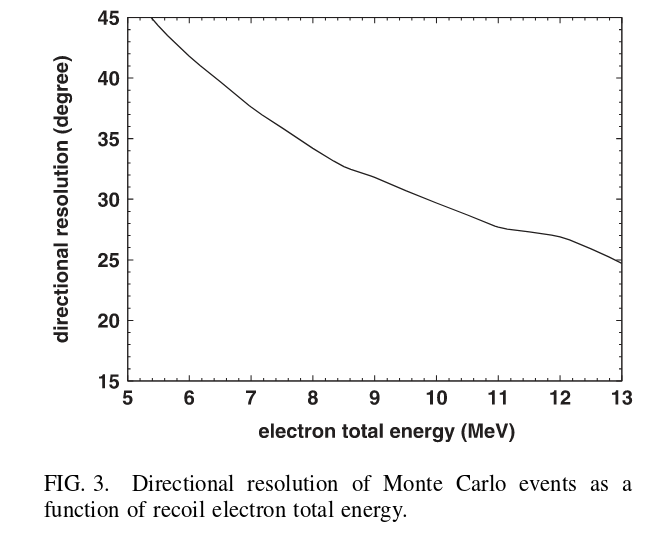
Figure 3 taken from
Cravens et al., Phys Rev D, 78, 032002 (2008)
Now, unfortunately, this telescope has a relatively high energy threshold: the low-energy neutrinos generated in the most common fusion reactions in the Sun will not be detected. Only the most energetic of those from the uncommon pp-III pathway will trigger the PMTs in sufficient numbers to pass the test.
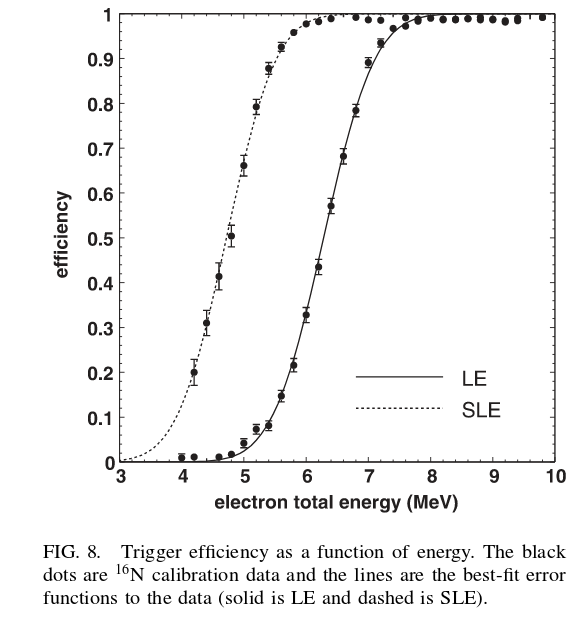
Figure 8 taken from
Cravens et al., Phys Rev D, 78, 032002 (2008)
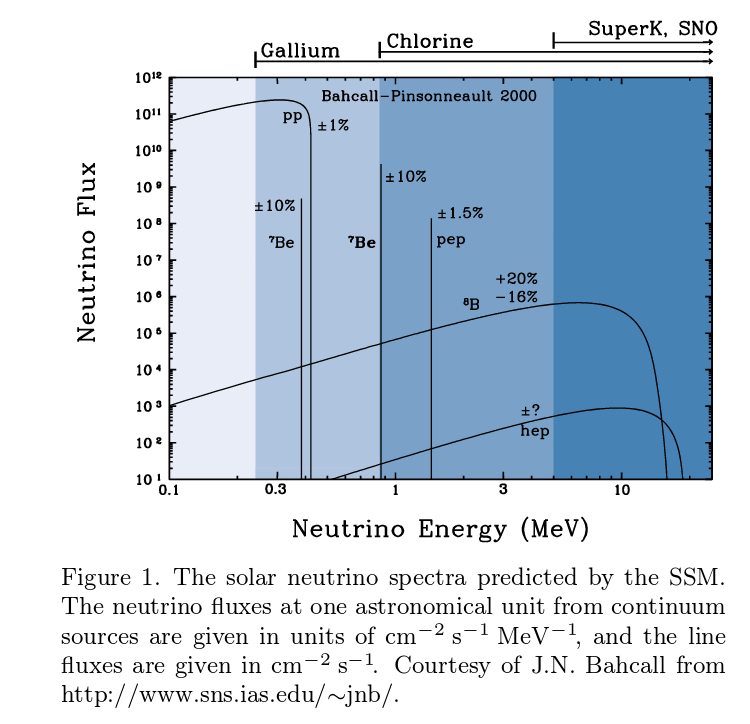
Figure 1 taken from
Review of Solar Neutrino Experiments
by A. Bellerive (2003)
Still, there are enough events recorded to build up pretty good statistics on solar neutrinos. For example, Super-K can tell that they actually come from the direction of the Sun ...
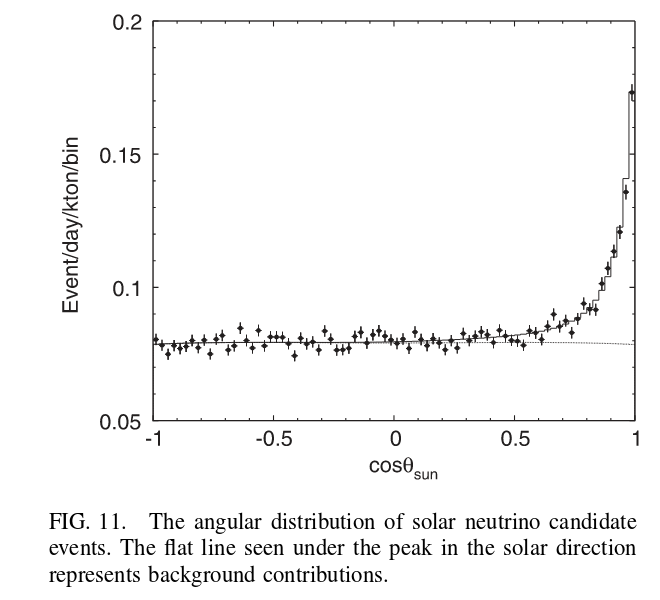
Figure 11 taken from
Cravens et al., Phys Rev D, 78, 032002 (2008)
... and that the rate of events increases and decreases in the expected manner as the Earth moves closer to and away from the Sun in its elliptical orbit.
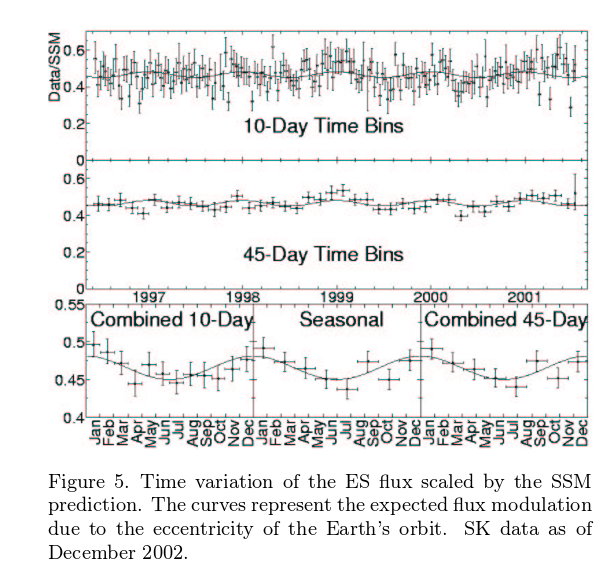
Figure 5 taken from
Review of solar neutrino experiments
by A. Bellerive, IJMPA, 19, 1167 (2004)
Q: When is the Earth closest to the Sun?
In order to create an even larger detector, some scientists decided, not to bring a lot of water deep underground, but to go to a place where lots of water is already deep below the surface: the ice cap of Antarctica!
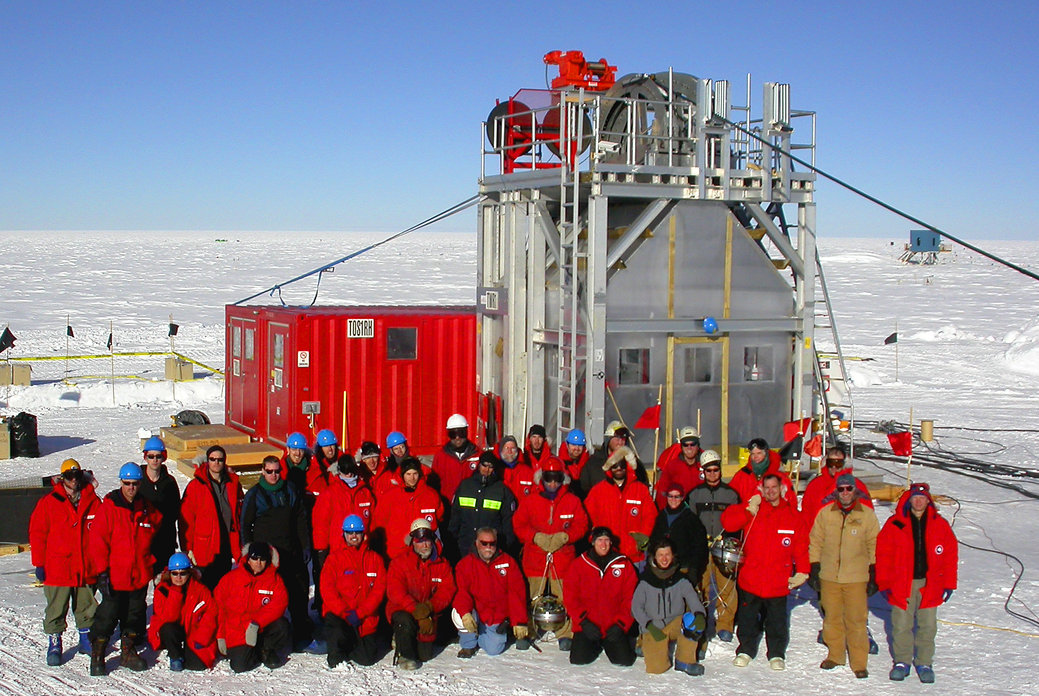
Image courtesy of
IceCube collaboration
The team drills holes more than a mile deep into the ice.
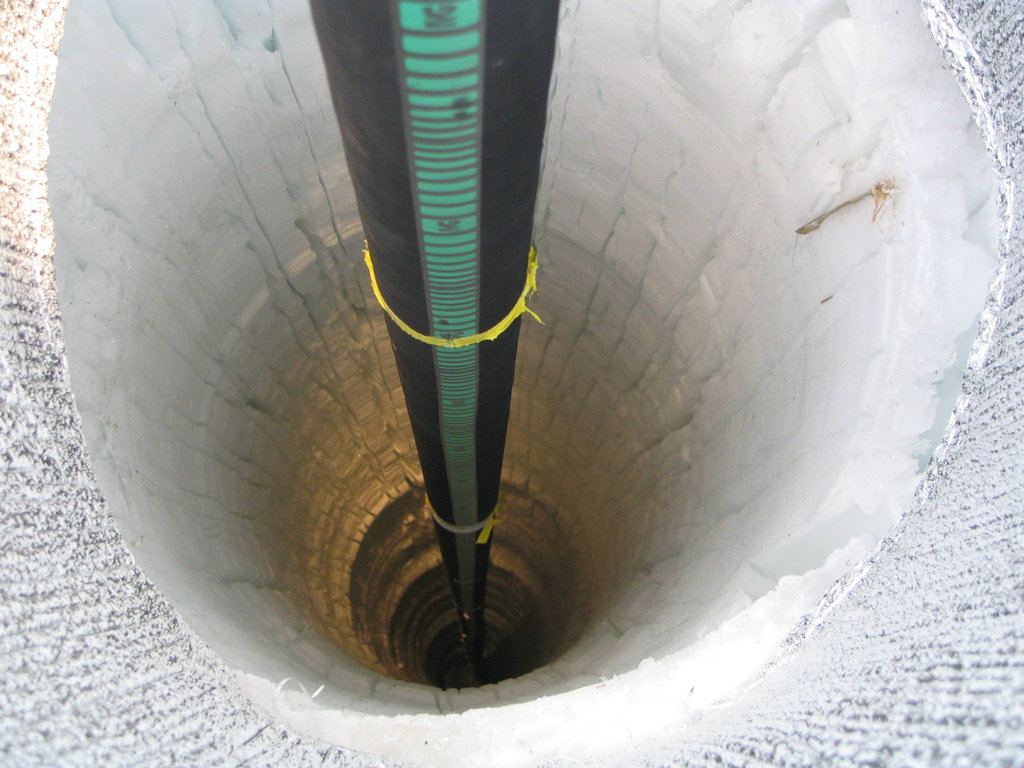
Image courtesy of
IceCube collaboration
Then they lower a long string of photodetectors into the hole.
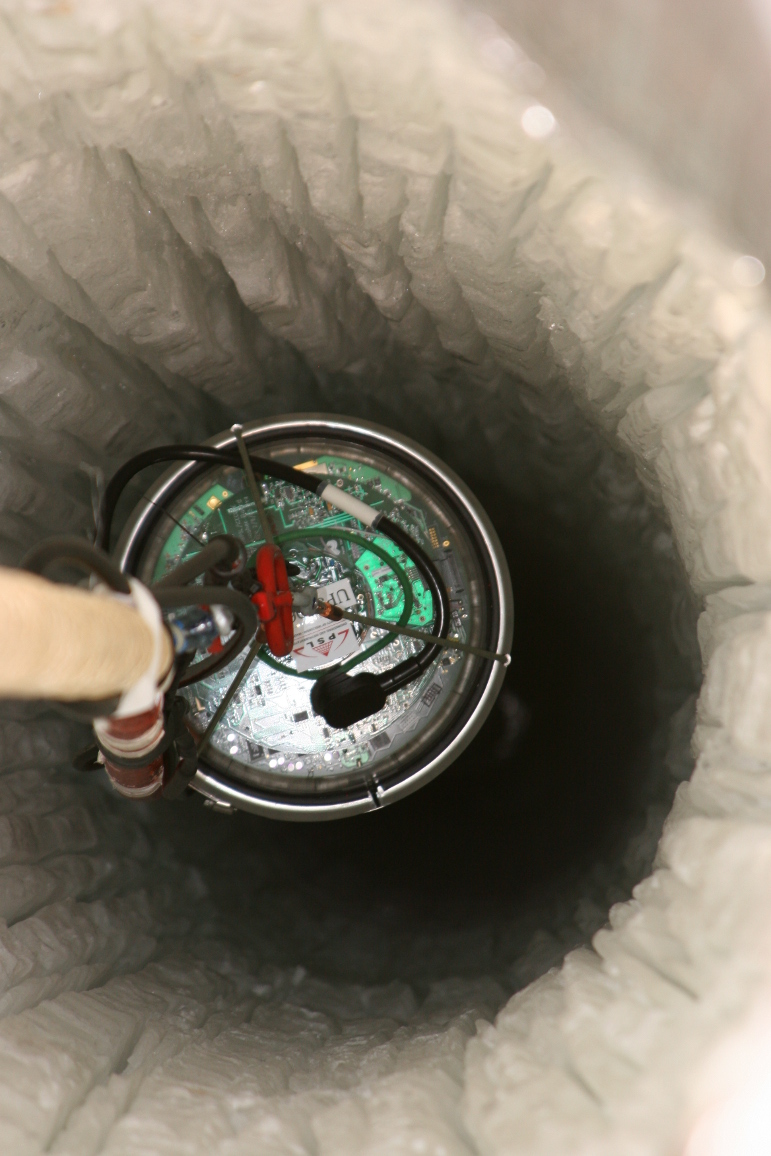
Image courtesy of
IceCube collaboration
The "telescope" consists of over 80 long strings, each containing 60 photomultiplier tubes. These sensitive light sensors sit over one kilometer below the surface of the ice, in a region which should be perpetually dark.
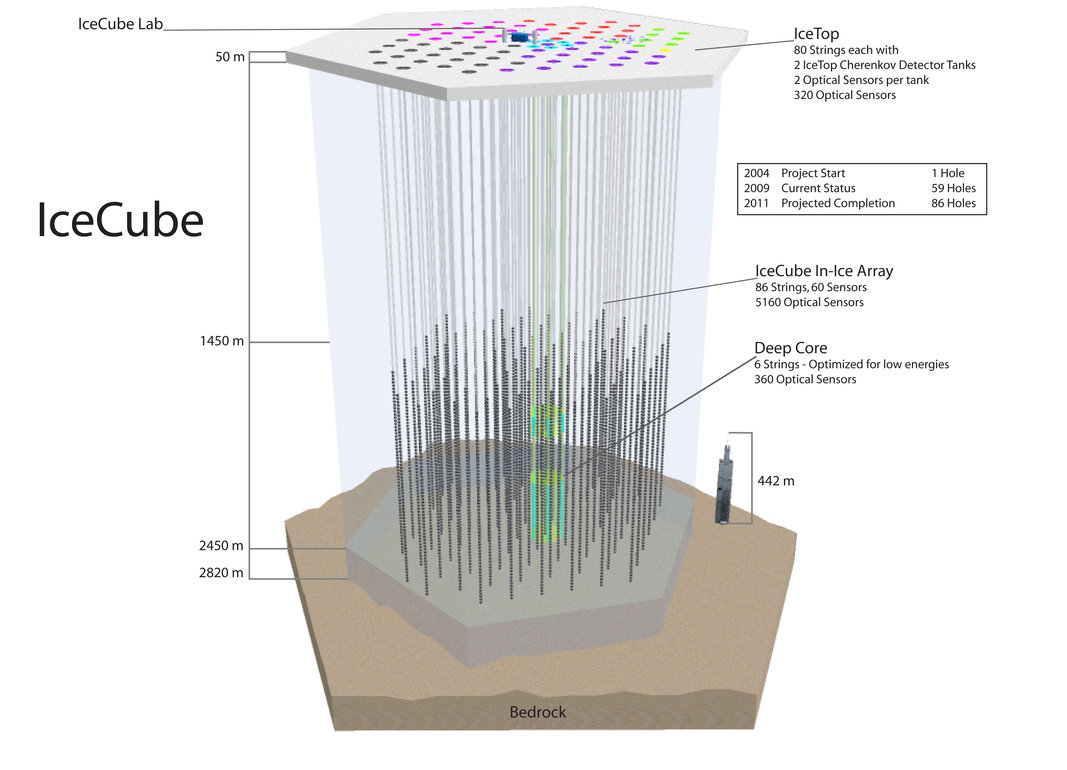
Image of IceCube courtesy of
Wikipedia and
The IceCube Collaboration
The volume in which Cerenkov light can be detected
is roughly 1 cubic kilometer.
Q: What is the number of electrons within this region?
Q: How does that compare to the number of electrons
in Super-K?
When a neutrino collides with an electron, it sends a shower of Cerenkov photons through the ice. Each photomultiplier tube records the time at which photons strike it, and sends that information to the surface; eventually, the direction and energy of the incoming neutrino can be estimated. (Click on the image below to start animation)
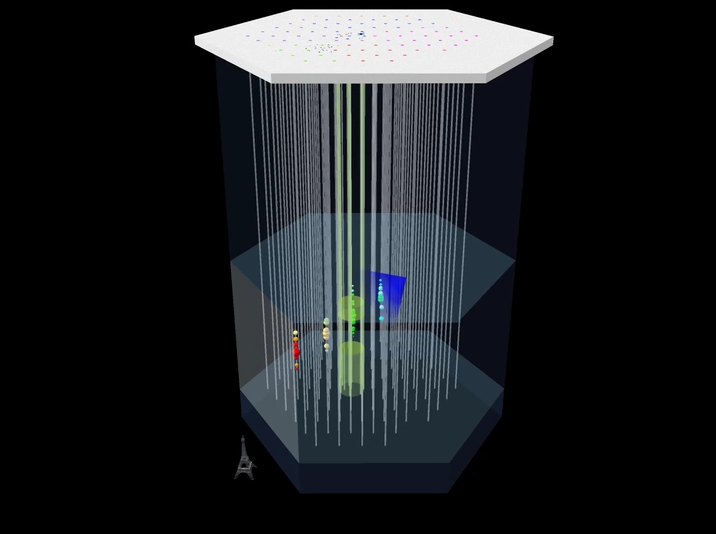
Animation courtesy of
IceCube collaboration
IceCube is concentrating on neutrinos with VERY high energies, greater than 1 TeV = 1,000,000 MeV; these are not created in the Sun, but by distant celestial sources: gamma-ray bursts? AGN? We are still trying to figure it out.
IceCube is also watching carefully to see if it detects any signals at the same time that LIGO or VIRGO detect a gravitational wave. So far, no positive reports.
For an example of recent IceCube news, see Astronomers Telegram 16462
Just a few days ago as of this writing (Sep 1, 2025), a new liquid-based neutrino detector began operation. You can find many details in this presentation by one of the Chinese scientists in charge of it.
In some ways, this is similar to the Kamiokande detector, as it is based on a giant tank filled with thousands of tonnes of liquid. But there's a big difference: this liquid isn't water, but a chemical called linear alkylbenzene. The difference is that charged particles created when a neutrino collides with one of the atoms create Cerenkov radiation in water (allowing us to detect the collisions) -- but only while the charged particles are travelling faster than the speed of light in water. That means that slower particles don't show up.
In this new detector, even the slower, sub-luminal charged particles create little flashes of light, allowing us to detect and measure the properties of the neutrino collisions. That makes the system more sensitive to neutrinos overall, and especially lower-energy neutrinos.
The main purpose of JUNO is to detect neutrinos emitted by nuclear reactors nearby, in order to test models of neutrino physics. The scientists in charge do hope to be able to detect particles from any nearby supernova as well, but that is a secondary focus.
SN 1987A and its neutrino burst
At the end of its life, a massive star has a central core consisting largely of chemical elements up the the iron group, surrounded by shells of successively lighter materials.
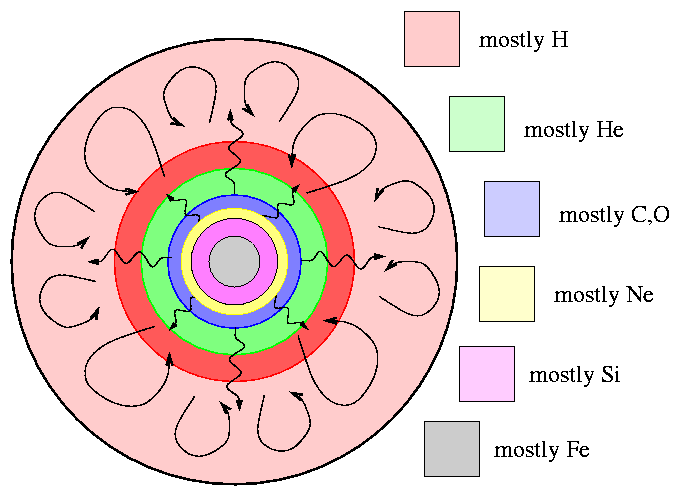
The mass of the central core is a few solar masses, and its size is roughly the same as the Earth. Let's use the following values for some order-of-magnitude estimation.
Mass of core: M = 1.5 solar masses = 3 x 1030 kg
Radius of core: R1 = 107 m
When the core runs out of fuel for further fusion -- remember that fusing iron-group elements together doesn't liberate energy, but sucks it out of the environment -- it collapses. The entire core shrinks, electrons and protons are forced together to form neutrons, and the core continues to collapse until neutron degeneracy pressure can (perhaps temporarily) bring things to a halt. At that point, the core is basically a ball of neutrons about 10 km in radius.
Radius of collapsed core: R2 = 104 m
As the core collapses, pretty much every proton merges with an electron to form a neutron, in a process which creates a electron neutrino:

Q: How many protons and electrons exist in the core before
the collapse?
Q: How many neutrinos should be generated by this initial
collapse-induced "squishing" of protons and electrons?
Supernova 1987A exploded in the Large Magellanic Cloud, at a distance of about 50 kpc from the Earth.
Q: What is that distance expressed in meters?
Q: Calculate the flux of neutrinos at the Earth
due to this burst; assume that it lasts
for 1 second.
Q: Estimate the number of neutrino-electron collisions
which would result in the Kamiokande detector.
Four detectors on Earth reported detecting neutrinos some time on Feb 23, 1987. After a bit of confusion, it seems that the measurements from the Kamiokande detector and the Brookhaven detector were probably real events caused by the supernova. Below is a table showing the 12 events detected at Kamiokande:
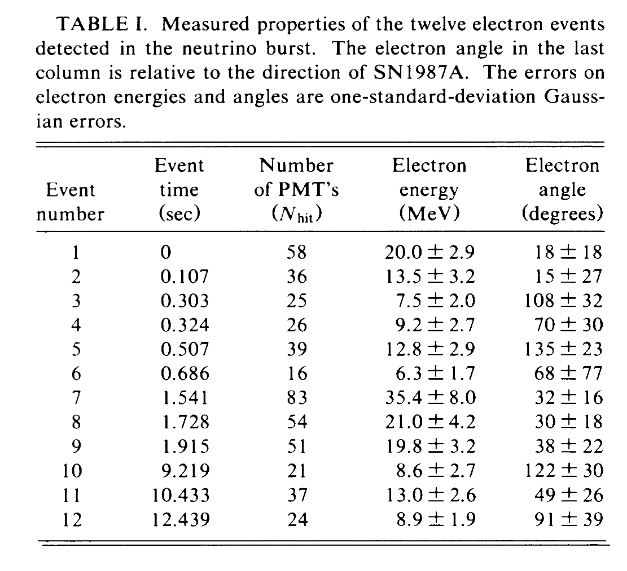
Table 1 from
Hirata et al., Phys Rev Lett 58, 1490 (1987)
Q: How does the number of these detections compare to the
number you calculated earlier?
Q: How many of these neutrinos came from a direction
close to the LMC?
As explained in Arafune and Fukugita, Phys. Rev. Lett. 59, 367 (1987) , it seems that only the first two events are due to electron neutrinos coming from the supernova. All the remaining events are probably due to collisions of electron anti-neutrinos with protons in the tank. Those anti-neutrinos were created during the very hot, very chaotic conditions inside the stellar core immediately after the collapse to neutron-star density.
These "post-squish" neutrinos outnumber the "squished" particles. That must take quite a bit of extra energy. What is its source? Just how much energy might be converted into neutrinos?
Q: What sort of energy might be available as a stellar core
collapses?
Let's compute the gravitational potential energy of the stellar core, before and after it collapses. Recall that the gravitational potential energy of a uniform sphere is

Q: What is the GPE of the core before it collapses?
Q: What is the GPE of the core after it collapses?
Q: How much energy is available as a result?
Q: A single neutrino of energy 10 MeV corresponds to 1.6 x 10-12 Joules.
How many such neutrinos could be generated from the
liberated GPE?
Astronomers have been on the lookout for bursts of neutrinos from supernovae in the succeeding years. We believe that, in galaxies like the Milky Way, about one star per century ought to explode as a core collapse supernova per century. Neutrino detectors have been on the case, on-and-off, for several decades; organized monitoring collaborations are bit younger.
So far, we're still waiting ...
 Copyright © Michael Richmond.
This work is licensed under a Creative Commons License.
Copyright © Michael Richmond.
This work is licensed under a Creative Commons License.